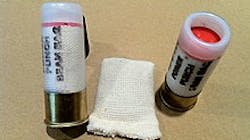The History of the Bean Bag Round
The 1960s and 70s were turbulent times in the United States with the civil rights movement and protests of the Vietnam War. College campuses had become a hotbed of student unrest as they protested an unpopular war for which they could be drafted. The war angered students of what they saw as the militarization of their campuses through military research and ROTC programs.[1] Protests became more widespread after the US invaded Cambodia when it was announced on television by President Richard Nixon on April 30, 1970. Nixon had been elected president on the promise of ending the war, but the invasion only increased it. The protests took a tragic turn five days later, on May 4, 1970, when twenty-eight Ohio National Guard soldiers opened fire on student protesters on the campus of Kent State University. Sixty-seven rounds were fired over thirteen seconds, killing four students and wounding nine.[2]
Protests on the University of California in Berkeley campus had been ongoing for months. It culminated on July 4, when over five hundred protesters marched through the city vandalizing businesses and looting. Not wanting to repeat what happened at Kent State, the Berkeley police added a new less-lethal weapon to their arsenal. Officially known as a Multiple Baton Shell, it shoots small wooden pellets from a gas-powered gun. The device was initially developed in 1967 in Hong Kong as they dealt with pro-Communist riots. After the Hong Kong police commissioner visited Berkeley to advise them on civil disturbances, they became the first department in the U.S. to begin using them.
The weapon is a small metal cylinder that shoots five wooden pellets about an inch and a quarter wide. They can travel a distance of seventy-five yards. It is intended to be extremely painful but not lethal. It proved successful when it dispersed protesters trying to flip a patrol car and set it on fire. The device was meant to replace tear gas canisters. It had become common for protesters to kick or throw the canisters back at the police. After the wooden blocks are fired, they are too light to be thrown back.[3]
There was still concern, not just among the public but the police as well, that the wooden pellets could inflict a lot of damage. In response to the campus protests, a company in San Ramon, California, was already designing a new weapon that would be safer than shooting wooden pellets. MB Associates, founded in 1962, specialized in applied physics, ordnance devices, advanced research and development, and special scientific devices.[4] Their most popular product was the Gyrojet, a handgun that shoots miniature rockets. Unlike inert bullets, the 13mm Gryojet shot a high-velocity spin-stabilized rocket with a solid fuel propellant.[5] Long out of production, they are now sought-after collector items, with one bullet costing as much as $100.
They invented a bean bag gun, sometimes called the “ungun.” The gun ejected a half-pound sack of BBs traveling about 120mph. The Berkeley police were the first to begin experimenting with the device while it was still in production. It was applauded as a better weapon because it would stun or incapacitate a person but not enough to kill or injure them. Unlike the wooden pellets, the key to the mildness of the bean bag’s impact is that the force is distributed over an area roughly the equivalent of a four-inch square bag. The company used the Army’s M-79 grenade launcher as the firearm for the bean bags.[6]
The final design of the weapon resembled a baton measuring eighteen inches. It saw its first use in San Francisco in December 1970 during protests surrounding a visit of the Vice-President of South Vietnam. Other major police departments in Salt Lake City and New Orleans were using the weapon. Kent State University also purchased the weapon along with the Ohio and New Mexico National Guard.[7] The company also produced the “world’s first less-lethal belt-fed, semi-automatic gun” capable of firing 250 bean bags a minute.[8] A civilian version of the weapon, the Prowler-Fouler, was marketed as a self-defense weapon at the protest of law enforcement agencies that believed that it could be used against them.[9]
There was a major push to explore other less lethal options. Another California firm, First Round Research, created the Ricochet Round. Each round consists of two hard putty-like plugs fired from a twelve-gauge shotgun. The round is fired at the floor halfway between the officer and the suspect. The round would bounce about eighteen inches off the floor, striking the suspect near the shins. It was a popular weapon among prison officials.[10]
In the late ’70s, the bean bag gun fell out of favor after a teenager died from a heart contusion when struck in the chest. MB Associates eventually went out of business. In 1990, the bean bag round was reintroduced by two different companies. MK Ballistics System, based in Hollister, California, and Defense Technology Corporation in Casper, Wyoming.[11] The bean bags were modified to be better than its predecessor and could be fired from a 12-gauge shotgun. Foam rubber bullets were also introduced as another less lethal option.[12] Today, bean bags and rubber bullets are popular, less lethal options for thousands of police departments nationwide.
[1] Schwerdtfeger, S. (2018). Kent State and Berkeley: Revolt and re-appropriation of the multiveristy in the spring of 1970. Voces Novae, 2(14),
[2] Lewis, J. & Hensley, T.R. (1998). The May 4 shootings at Kent State University: The search for historical accuracy. https://www.kent.edu/may-4-historical-accuracy
[3] “Wood pellets fired by Berkeley police. The San Francisco Examiner. July 6, 1970.
[4] “SR Valley major area for industry.” Contra Costa Times. April 30, 1967.
[5] “12 ounces of death.” The Des Moines Register. July 3, 1965.
[6] “Berkeley police to test ‘bean bag’ gun.” The San Francisco Examiner. July 24, 1970.
[7] “Experiments with stun guns.” The Philadelphia Inqurier. August 4, 1971.
[8] “Antiriot guns are stunning.” The Sacramento Bee. July 28, 1972.
[9] “‘Prowler-Fouler’ can be dangerous.” Journal and Courier. November 25, 1972.
[10] “Non-lethal weapons are the newest police tool.” The Herald-News. November 26, 1971.
[11] “Bean bag ammunition packs a wallop.” Record Searchlight. May 21, 1995.
[12] “Police studying the use of ‘less-than-lethal’ force.” The Baltimore Sun. September 2, 1997.
About the Author
Robert Bowling is a retired police officer from Fishers (IN) and Durham (NC) police departments. He has served in a variety of roles to include, Field Training Officer, Honor Guard, Evidence Technician, Traffic Crash Reconstructionist, Hostage Negotiator, School Resource Officer, and Crisis Intervention Stress Management team member. His true passion is history and he became the first historian and curator for the Fishers Police Department.
After retirement, he has continued his passion for history focusing on law enforcement and fallen officers. He is an historical researcher for the Officer Down Memorial Page. He is the author of the book Wicked Fishers and serves on the boards of a few historical organizations. He currently teaches Criminal Justice for a local high school.
About the Author

Robert Bowling
Robert Bowling is a retired police officer from Fishers (IN) and Durham (NC) police departments. In retirement, he has continued his passion to honor fallen officers. He is an Ambassador for the National Law Enforcement Memorial, as well as an historical researcher for the Officer Down Memorial Page. He also has a passion for history, focusing primarily on law enforcement history. He is a member of the Police History Society and is the author of the book Wicked Fishers. He currently teaches Criminal Justice for a local high school.
